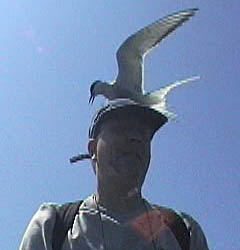Although the holiday in Florida was not a wildlife or birdwatching trip, we did fit in a few days at local nature reserves.
In Orlando iteself the Tibet-Butler Preserve was a little oasis of calm. A mixed habitat including long leaf pine and saw palmetto was a pleasure to stroll through on a cloudless day.

Even before we left the Preserve buildings this mantis-like bug proved to be an interesting if not beautiful find.


More insects were around in the trees, including this jumbo sized wasp-type creature - not quite the crow sized beast Kay described, but certainly a good 4 cms long

Strung between the trees was this fabulously marked spider - for a second I thought it was the head of some fearsome grasshopper or cricket, until I saw the tucked in legs. Still had a few doubts until I saw another on Merritt Island.

Birdlife in the main reserve was a bit shy, more heard than seen, but there were a few flowering plants including this one which had a scent remiscent of some orchids.

More interesting still were some of the lichens - the blood red ones on trees, and these fascinating little balls, gathered in clumps in the undergrowth.


Regularly scattering the ubiquitous small lizards which roamed the boardwalks, eventually we came out into an area of open water.


I presume the dead looking trees were cypress in their winter garb. The colour helped to highlight the several ospreys that came in to feed, and in the water itself a disturbance revealed itself to be a turtle sneaking through the lily pads. When it went into clear water an almost unreal red veining of the shell and limbs became apparent, although the contrasting light above and below water defeated the cameras sensor!


Over at Cape Canavaral we planned to squeeze in a trip to the Merritt Island Wildlife Refuge before visiting the Kennedy Space Centre, but the wildlife got in the way, so Kennedy will have to wait!
Merritt Island has several nature trails and the Black Point Wildlife Drive - a seven mile long 'self-guided auto tour' - basically a drive through nature reserve.
The trails were short' but interesting enough. Within minutes Kay spotted a couple of woodpeckers, of which this Pileated woodpecker was the most amenable to posing. The picture doesn't portray its sheer size, as it piledrived small chunks of bark from the tree.
Crashing through the undergrowth we found another armadillo

The vegetation included wild oranges,

welded trees,

poison ivy (somehow I expected something a bit more spectacular)

as well as several epiphytes lodged in the trees - air plants,

Bromeliads,

and what I believe was called Cardinal Wild Pine

In a nearby pond was a largemouth bass

and then a kind local pointed us down a track to a small pond with a large alligator on (thankfully) the far side. We saw quite a few wild 'gators, but somehow this one felt the most wild.


Maybe it was the duckweed!
The Black Point Wildlife Drive was better than I expected, although one of my enduring memories was the American guy with the big lens SLR perched high on the back of his convertible, directing his wife in minute detail as to how she should position the car so he could get the best shot!
As well as a host more 'gators, which seemed to be the main attraction to most of the visitors, there was a good range of birds:
Tricoloured heron

Snowy Egret

Wood Stork

Male Roseate Spoonbill

and the less in-your-face coloured female

Green Backed Heron

Glossy Ibis

and male

and female Anhingas,

while overhead flew black vultures.
After Black Point we headed for the manatee viewpoint, but there were none there. Never mind - it had been a great day.A flying trip down to the Florida Keys to swim with Dolphins - fantastic, but not wild! - led to encounters with pelicans

a softback turtle
Laughing Gulls
this barracuda-type fish
and the joys of Miami Beach.

The one creature that I still yearned to see in the wild was a manatee - a bizarre creature that reminded me of a giant waterborne tick, with that huge body and that tiny head. Funny how these images just come into your mind! Sure you got great views of the rescued ones at Seaworld .............

but that's not the same. So we phoned Captain Joe of Fun2Dive and booked a trip to the Crystal River Reserve. If you want to see manatee and have a great day out, book with Captain Joe - not his advert, just my opinion.

He'll only take 6 at a time and he will work his not inconsiderable butt off to show you the manatee. Although swimming is quite tightly controlled now you can still get close to them with some patience, a gentle approach and a manatee that is happy to be there. It took a while, the water was murkier than ideal, but I did get to swim alongside this one for 5-10 minutes. Fantastic. (That's it's head by the way!)

Crystal River was good for birds too.
Great Blue Heron

Brown Pelican

Great Egret - look at those feathers

and, to cap it all, perhaps the best views of osprey I'll ever have


